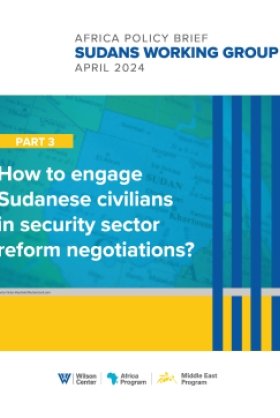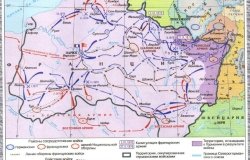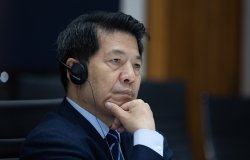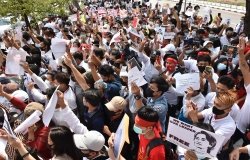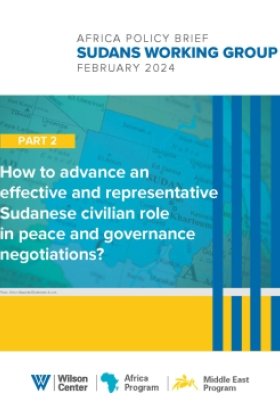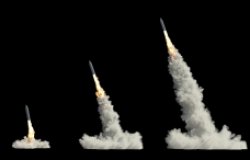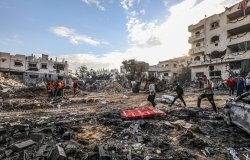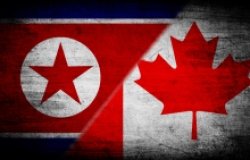Kennan Cable No. 89: Ensuring the Future of European Security Amidst a New Cold War with Russia
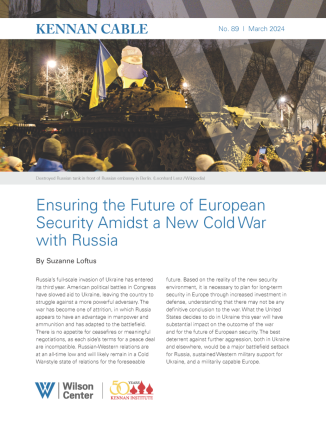

Russia’s full-scale invasion of Ukraine has entered its third year. American political battles in Congress have slowed aid to Ukraine, leaving the country to struggle against a more powerful adversary. The war has become one of attrition, in which Russia appears to have an advantage in manpower and ammunition and has adapted to the battlefield. There is no appetite for ceasefires or meaningful negotiations, as each side’s terms for a peace deal are incompatible. Russian-Western relations are at an all-time low and will likely remain in a Cold War-style state of relations for the foreseeable future. Based on the reality of the new security environment, it is necessary to plan for long-term security in Europe through increased investment in defense, understanding that there may not be any definitive conclusion to the war. What the United States decides to do in Ukraine this year will have substantial impact on the outcome of the war and for the future of European security. The best deterrent against further aggression, both in Ukraine and elsewhere, would be a major battlefield setback for Russia, sustained Western military support for Ukraine, and a militarily capable Europe.
The State of the War and Future Prospects
Ukraine’s highly anticipated counteroffensive in 2023 was mostly unsuccessful. This is due to a number of reasons such as insufficient training of new battalions, the transparency of the battlefield from the use of drones, Russia’s entrenched and highly mined defense fortifications and technological adaptation, Ukraine’s lack of long-range missiles to degrade Russian supply lines, and difficulty conducting combined arms operations.[1] Ukraine has also had some important successes, which include partially degrading Russia’s Black Sea fleet, leading some of its ships to move to other ports, effectively breaking the Russian naval blockade of Ukrainian grain.
Moscow has dramatically increased its military output and receives strategically important weapons—such as drones, ammunition, and ballistic missiles—from partners like North Korea and Iran. It has managed to bolster its weapons manufacturing by increasing trade with China, which allows it to acquire dual-use technology. At this stage, Russia outmans and outguns Ukraine. It is producing ammunition at a much faster rate than NATO countries.[2] Russia’s now wartime economy can replace lost capabilities at a faster rate than the West is replacing Ukrainian capabilities.[3]
Because this is a war of attrition, whichever side manages to replace capabilities faster, adapt to the battlefield faster, and degrade the capabilities of the other faster is the side that will have the advantage. It is still possible for Ukraine to achieve a battlefield victory through persistent attrition, battlefield adaptation, technological innovation, and force structure improvements.[4] Of course, Ukraine is far likelier to succeed with increased support from the West, particularly the United States. Because Ukraine doesn’t have the capacity to mount another offensive this year, it should focus on defense in 2024, which is less costly but can still wear the opponent down and allow time to prepare for offensive action in 2025.
Meanwhile, Russia appears to be able to maintain its war efforts for the foreseeable future. The Russian economy has adapted quite well to sanctions by circumventing them through third countries like China and countries in Central Asia.[5] Russia also continues to maintain strong trade ties with the Global South, enabling its connection to the global economy outside of the political West. The Russian economy continues to grow at a steady pace, though inflation is high.[6]
The Kremlin has been able to maintain high levels of popular support for the war by providing payments to families of deceased soldiers and redistributing rents to elites.[7] Moreover, increased domestic repression has suppressed dissent and many of those against the war have fled the country. Unemployment is at a record low in Russia, wages are higher, and targeted social spending schemes have been set up, all to mitigate the domestic impacts of excess spending on the military.[8]However, questions remain on how sustainable these measures are.
The Kremlin has refocused this war as a larger contest against the West, a narrative which has effectively mobilized continuous public support, especially given the Kremlin’s total control over the flow of information. About half a million new recruits have been successfully added through campaigns last year without imposing a new wave of partial mobilization, an effort which will continue throughout 2024.[9] Nevertheless, support for the war may wane if Russia starts to experience increasing setbacks.
No Real Prospects for Peace
A negotiated settlement is unrealistic today, particularly because Russia and Ukraine are unlikely to reach any agreements on territorial disputes. Also, public opinion in both Ukraine and Russia is rather hawkish. Ceding territory or relinquishing conquests will appear treasonous to the public and affect public support of political leaders.[10]
Many wars do not see definite conclusions, and this war may be no different. Several frozen conflicts continue to exist in the post-Soviet space, including in Georgia and Moldova. The Korean peninsula faces a similar reality. In the Korean armistice, the de facto situation does not necessarily reflect the position advanced by either South Korea or North Korea, as both officially assert claims to the entire peninsula, despite the clear line of demarcation between their areas of control. The war in Ukraine may face a similar future, after one side manages to wear the other one down and achieves long-term deterrence through a partial victory.
Despite these realities, advocates for a peace deal insist that a settlement is still viable in Ukraine today. Such arguments posit that because Russia seems to have the advantage, Ukraine is on its way to collapsing and therefore needs to accept a deal.[11] This argument is based on a number of assumptions, including Ukraine’s inability to adapt to the battlefield, Western incapacity to manage weapon stock depletions, the importance of manpower over battlefield adaptation and technological innovation, and the desirability of a settlement among all parties. It misses the reality that the West and Russia are in a new Cold War that has the potential of turning hot, a state of relations that is likely to persist while the current regime is still in power, if not beyond. And most obviously, the argument ignores the fact that Ukraine will never accept occupation of any of its territory, let alone negotiate with the current regime in Russia.
Arguments for a negotiated settlement also tend to overestimate the bargaining potential of Ukraine’s NATO membership bid in a potential agreement. While such a bargaining chip may have been useful in the prevention of all-out conflict, once the war developed into the long war of today, it becomes redundant and obsolete. While Ukraine may not be an official NATO member, it receives significant military aid from NATO to fight off Russia, rendering it de facto part of the Western military bloc. Therefore, a promise to keep Ukraine out of NATO doesn’t lead to any substantial gains for Russia in a negotiation because such levels of military cooperation would be maintained or even increased as part of future “security guarantees” for Ukraine. Moreover, because territorial disputes are unlikely to be resolved in the event of a ceasefire, official NATO membership remains complicated for Ukraine, as their resolution would be a prerequisite for membership.
Since NATO’s level of support for Ukraine is not enough to act as an effective deterrent, it needs to make the war costlier for Russia to endure. Bolstering support for Ukraine will also be necessary to maintain a long-lasting ceasefire after gaining a battlefield advantage. In an eventual discussion on security guarantees for Ukraine’s future, providing Ukraine with what it needs to achieve that advantage would be the most effective practical step.
US Aid to Ukraine and Long-Term Security in Europe
What the United States decides to do in Ukraine this year will have substantial impact on the outcome of the war and for the future of European security. It can either help Ukraine rebuild its offensive forces and build solid defense lines or it can cede an irreversible advantage to Russia. Should the United States decide to reduce or halt further aid to Ukraine, it is likely that the Russians will advance in Ukraine and seize more territory. Ukraine will likely lose the war in this scenario, which could lead to its eventual subjugation.
A subjugated Ukraine has no chance of integrating into the European Union, which would send a negative signal to other aspiring nations such as Moldova. This would make it seem as though the United States does not prioritize stemming Russian influence in Eastern Europe, a force which has arguably stalled political reforms in this region. Countries that are already politically vulnerable to Russian influence would become more vulnerable to Russian influence and coercive diplomacy. The Russia of today poses an increased political and military threat to the continent as it has consolidated an anti-Western stance through the development of deep resentment for its perceived grievances and is actively fighting a war with the West, using Ukraine as the battlefield.
Reducing aid to Ukraine would make the United States look like an unreliable partner to its European allies and international partners. This would send a strong signal that the United States is not fully prepared to back another partner for “as long as it takes” should, say, China attempt to invade Taiwan. Many such American partners in the Indo-Pacific may choose to hedge against American reluctance and align with China instead.
The West needs to shift to a longer-term plan in Ukraine to successfully attrit Russian forces. This plan should prioritize not ceding the advantage to Russia this year through a strong defense, militarily outproducing Russia in the long run, and achieving an important battlefield advantage over time. Training of new battalions in Ukraine will need to be longer, more effective, and prioritize battlefield adaptation. Ukraine will also have to incorporate younger, more capable soldiers. The West will have to continue maintaining lines of communication with Moscow to monitor for escalation, which has so far been manageable. Sending the right weapons to Ukraine will bolster its ability to seize its needed advantage on the battlefield. Long-range missiles have contributed to Ukraine’s success by degrading Russian logistics and capabilities and have so far not resulted in disproportionate retaliation despite initial fears.
In addition, the issue of long-term security in Europe needs to be urgently re-prioritized. The longer the war goes on and the more antagonistic relations become between the West and Russia, the greater the strategic necessity arises to build military capabilities as a deterrent. If Europe does not re-arm while Russia continues to do so during and after the war, it will face a much larger and better-armed adversary on its doorstep. This will be especially threatening if Russia achieves victory in Ukraine.
European NATO members need to plan for long-term security and stability in Europe, understanding there is no return to normalization of relations between the West and Russia for the foreseeable future. Re-arming Europe has also become a necessity and an immediate priority to serve as a potential hedge against a United States either distracted by other security demands or retreating into an isolationist posture. The model for a robust defense system in Europe that is most likely to succeed and be accepted by transatlantic partners is that of a “European pillar in NATO.”[12] This model would address the need for Europeans to assume more responsibility for their own security, act independently if necessary and include the important role of the United Kingdom in European defense. In the event of a regional war, Europe currently lacks the resources and capabilities to effectively counter a peer adversary without the United States. Europe should aim to be the defender of first resort for any threat to the continent and have the United States be its defender of last resort.
According to a recent RAND report, a robust NATO posture in Eastern Europe after the war’s end could cause significant strategic instability, both in the event of a favorable outcome to the war and in the event of an unfavorable one.[13] The report’s central argument relies on the assumption that Russia only reacts aggressively in response to assertive Western military policy but not out of opportunistic aggression. But this assumption misses the new strategic reality in Europe. Russia has plans to expand its military force in the coming years and is investing as much as 6% of its GDP into the military.[14] According to Estonia’s Foreign Intelligence Service, Russia is preparing for a military confrontation with the West within the next decade. This assessment is based on Russian plans to double the number of forces stationed along its northwestern border with NATO.[15] Even if this constitutes mere preparation rather than concrete plans to militarily confront the West, advising NATO not to adopt similar preparations is reckless. In Russia’s preparations for a possible confrontation with the West, it may employ coercive tactics or military aggression against non-NATO neighboring countries to be able to position its forces and capabilities closer to NATO countries, as doing so would increase its strategic advantage in the event of a regional war.
After more than 30 years of building up grievances as a result of its perception of being sidelined by the West, it would be a grave error to assume that Russia would willingly give up its military plans for the idea of stabilizing Europe. The Russian regime will not repeat what it perceives were mistakes in its approach to the West during the post-Cold War era. Assertive policies are here to stay, regardless of the outcome of the war. Europe has no choice but to apply more hardline policies towards its defense and accept the reality of a new Cold War with Russia. The strongest future deterrent to any further instance of Russian aggression is for Russia to face a loss in Ukraine, sustained Western commitment to Ukraine, and a militarily capable Europe. A weakened Russia, next to a stronger Europe, would be less capable of rebuilding its military, coercing neighboring countries, and re-invading Ukraine.
Conclusion
A loss in Ukraine will show adversaries of the United States that it cannot handle multiple challenges at once. If it backs down from supporting its partners, it will be admitting that it can no longer achieve its objectives in areas of strategic interests—and a European security theater with an emboldened Russia will create a host of new problems.
To ensure long-term stability in Europe, the United States needs to back Ukraine for as long as it takes, even in a long war of attrition. To achieve proper deterrence, the West needs to support Ukraine in seizing a clear advantage on the battlefield, ensure its long-term protection, and invest in a European pillar in NATO. To be prepared to handle the uncertainty that comes with a new Cold War, proper defense in Europe has become a necessity. And no matter how the war unfolds in Ukraine or how political battles get resolved in the United States, Europe needs to confront the glaring need to develop its own strong military capacity. The alternative is an uncertain and unstable future where Europe may need to bend to Russia’s will or face an increasingly distracted or isolationist partner on the other side of the Atlantic.
[1] Michael Kofman and Rob Lee, “Perseverance and Adaptation: Ukraine’s Counteroffensive at Three Months,” War on the Rocks, September 4, 2023, https://warontherocks.com/2023/09/perseverance-and-adaptation-ukraines-counteroffensive-at-three-months/
[2] Erin Snodgrass, “Russian Manufacturers Are Making up to 7 Times as much Ammunition as Western Arms Makers, Estonian Defense Official Says,” Business Insider, September 13, 2023, https://www.businessinsider.com/russia-ammunition-manufacturing-ukraine-west-officials-2023-9
[3] Kofman and Lee, “Perseverance and Adaptation”; and Michael Kofman, Rob Lee, and Dara Massicot, “Hold, Build, and Strike: A Vision for Rebuilding Ukraine’s Advantage in 2024,” War on the Rocks, January 26, 2024, https://warontherocks.com/2024/01/hold-build-and-strike-a-vision-for-rebuilding-ukraines-advantage-in-2024/
[4] Franz-Stefan Gady and Michael Kofman, “Making Attrition Work: A Viable Theory of Victory for Ukraine,” Survival 66, no. 1 (February 6, 2024): 7–24, https://www.tandfonline.com/doi/full/10.1080/00396338.2024.2309068
[5] Joby Warrick, “In Central Asia, a Hidden Pipeline Supplies Russia with Banned Tech,” Washington Post, July 18, 2023, https://www.washingtonpost.com/national-security/2023/07/18/russia-sanctions-weapons-china-drones/
[6] Alexander Marrow, “Russia's Economic Growth to Slow in 2024 as High Interest Rates Linger, Reuters Poll Shows,” Reuters, December 22, 2023, https://www.reuters.com/markets/europe/russias-economic-growth-slow-2024-high-interest-rates-linger-2023-12-22/
[7] “Families of Russian Soldiers Killed in Ukraine to Be Paid over 7 mln Rubles Lump Sum—Putin,” Interfax International Information Group, March 3, 2022, https://interfax.com/newsroom/top-stories/75349/; and Max Bergmann, Maria Snegovaya, and Michael Kimmage, “Aid to Ukraine and the Future of the War with Michael Kofman,” Russian Roulette (podcast), CSIS, January 11, 2024, https://www.csis.org/podcasts/russian-roulette/aid-ukraine-and-future-war-michael-kofman
[8] Daniel Harper, “Russia Approves Record Spend for its Military in New 2024 Budget,” Euronews, November 28, 2023, https://www.euronews.com/business/2023/11/28/russia-approves-record-spend-for-military-in-new-budget
[9] Farida Rustamova, “How Russian Officials Plan to Recruit 400K New Contract Soldiers in 2024,” Moscow Times, December 22, 2023, https://www.themoscowtimes.com/2023/12/22/how-russian-officials-plan-to-recruit-400k-new-contract-soldiers-in-2024-a83509
[10] Rustamova, “How Russian Officials Plan to Recruit 400K New Contract Soldiers.”
[11] Anatol Lieven and George Beebe, The Diplomatic Path to a Secure Ukraine (Washington, DC: Quincy Institute for Responsible Statecraft, February 2024), https://quincyinst.org/wp-content/uploads/2024/02/QUINCY-PAPER-NO.-13-%E2%80%94-BEEBE-LIEVEN-3.pdf
[12] Anna Wieslander, “How France, Germany, and the UK Can Build a European Pillar of NATO,” Atlantic Council, November 23, 2020, https://www.atlanticcouncil.org/commentary/article/how-france-germany-and-the-uk-can-build-a-european-pillar-of-nato/
[13] Samuel Charap and Miranda Priebe, Planning for the Aftermath Assessing Options for U.S. Strategy Toward Russia after the Ukraine War (Santa Monica, CA: RAND, February 9, 2024), https://www.rand.org/content/dam/rand/pubs/research_reports/RRA2500/RRA2510-2/RAND_RRA2510-2.pdf
[14] Agence France-Presse, “Boosted by Military Orders, Russia’s Economy Grows by 3.6%,” SCMP, February 8, 2024, https://www.scmp.com/news/world/russia-central-asia/article/3251357/boosted-military-orders-russias-economy-grows-36
[15] Andrius Sytas, “Russia Preparing for Military Confrontation with West, Says Estonia,” Reuters, February 13, 2024, https://www.reuters.com/world/europe/russia-preparing-military-confrontation-with-west-says-estonia-2024-02-13/
About the Author

Suzanne Loftus
Former Professor of Strategic Security Studies, George C. Marshall European Center for Security Studies; Adjunct Associate Professor, Georgetown University

Kennan Institute
The Kennan Institute is the premier US center for advanced research on Russia and Eurasia and the oldest and largest regional program at the Woodrow Wilson International Center for Scholars. The Kennan Institute is committed to improving American understanding of Russia, Ukraine, Central Asia, the Caucasus, and the surrounding region though research and exchange. Read more


